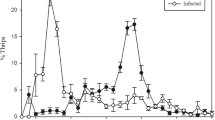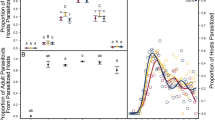Abstract
PARASITES can modify host behaviour for their own benefit after infection1–4. Whether these changes also minimize loss of host fitness is less well known5–7. Although parasitoids are abundant8, few cases are known of behavioural changes in host–parasitoid systems9. Bumblebees (Bombus spp., Apidae, Hymenoptera) are primitively eusocial insects with an annual life cycle. Reproduction occurs in late summer when males and young queens are released10,11. Parasitoid conopid flies (Conopidae, Diptera) are abundant in summer, and up to 70% of field-caught bumblebee workers may be parasitized12. Development of the parasitoid usually takes 10–12 days and ends with the host's death when the larva pupates. Here we report a novel strategy used against these parasitoids, based on the exploitation of temperature effects on parasite development. We demonstrate that parasitized workers of the bumblebee Bombus terrestris L. stay in the field overnight rather than returning to their nest. This behaviour retards the development of the parasite and reduces the chances of successful development. In choice experiments, parasitized foragers actively seek out cold temperatures. This behaviour therefore enhances colony success by prolonging the life of parasitized workers while at the same time reducing parasitoid fitness.
This is a preview of subscription content, access via your institution
Access options
Subscribe to this journal
Receive 51 print issues and online access
$199.00 per year
only $3.90 per issue
Buy this article
- Purchase on Springer Link
- Instant access to full article PDF
Prices may be subject to local taxes which are calculated during checkout
Similar content being viewed by others
References
Holmes, J. C. & Bethel, W. M. Zool. J. Linn. Soc. 51 (suppl), 123–149 (1972).
Brodeur, J. & McNeil, J. N. Science 244, 226–228 (1989).
Brodeur, J. & McNeil, J. N. Ecol. Entomol. 17, 97–104 (1992).
Moore, J. Evolution 64, 1000–1015 (1983).
Smith Trail, D. R. Am. Nat. 116, 77–91 (1980).
Minchella, D. J. Parasitology 90, 205–216 (1985).
McAllister, M. K. & Roitberg, B. D. Nature 328, 797–799 (1987).
Price, P. W. Evolutionary Biology of Parasites (Princeton Univ. Press, Princeton, 1980).
Godfray, H. C. J. Parasitoids; Behavioural and Evolutionary Ecology (Princeton Univ. Press, Princeton, 1993).
Alford, D. V. Bumblebees (Davies-Poynter, London, 1975).
Heinrich, B. Bumblebee Economics (Harvard Univ. Press, Cambridge, MA, 1979).
Schmid-Hempel, P., Müller, C., Schmid-Hempel, R. & Shykoff, J. A. Ins. Soc. 37, 14–30 (1990).
Schmid-Hempel, R. & Müller, C. B. Anim. Behav. 41, 910–912 (1991).
Gilbert, N. J. Anim. Ecol. 53, 589–597 (1984).
Heinrich, B. & Heinrich, M. J. E. Physiol. Zool. 56, 563–567 (1983).
Smith, K. G. V. & Cunningham-van Someren, G. R. J. nat. Hist. 4, 439–446 (1970).
Kluger, M. J. Fever (Princeton Univ. Press, Princeton, 1979).
Louis, C., Jourdan, M. & Cabanac, M. Am. J. Physiol. 250, R991–R995 (1986).
Boorstein, S. M. & Ewald, P. W. Physiol. Zool. 60, 586–595 (1987).
Author information
Authors and Affiliations
Rights and permissions
About this article
Cite this article
Müller, C., Schmid-Hempel, P. Exploitation of cold temperature as defence against parasitoids in bumblebees. Nature 363, 65–67 (1993). https://doi.org/10.1038/363065a0
Received:
Accepted:
Issue Date:
DOI: https://doi.org/10.1038/363065a0
This article is cited by
-
Thermoregulatory response of Frankliniella occidentalis (Pergande) (Thysanoptera: Thripidae) to infection by Beauveria bassiana, and its effect on survivorship and reproductive success
Scientific Reports (2019)
-
Demographic benefits of early season resources for bumble bee (B. vosnesenskii) colonies
Oecologia (2019)
-
Transmission and terrestrial dispersal of non-native ectosymbionts on invasive crayfish
Hydrobiologia (2018)
-
Pathogens, parasites, and parasitoids associated with bumble bees (Bombus spp.) from Uruguay
Apidologie (2017)
-
Flight behaviour of honey bee (Apis mellifera) workers is altered by initial infections of the fungal parasite Nosema apis
Scientific Reports (2016)
Comments
By submitting a comment you agree to abide by our Terms and Community Guidelines. If you find something abusive or that does not comply with our terms or guidelines please flag it as inappropriate.



